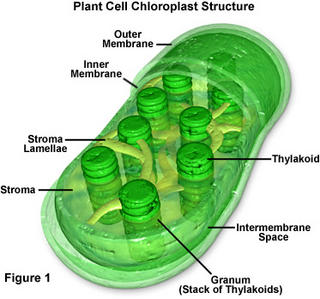Its me again. :) I have been dealing with this research for quite a while, and my readings have confirmed that mitochondria and chloroplasts really share a multitude of similarities be it in their double-membrane structure or the raw materials of their digestion and products of metabolism. Their function and highly specialized membrane structure seems to suggest that these organisms are, at one time of their life, free living species who turned to become endosymbionts to compensate for their structural and functional flaws and live in cahoots with the cell to aid each other for perpetual existence. Please read on the article below for more information about this issue. I will post more articles regarding this topic in the next few days to add to your readings about the two intriguing organelles. Thanks for visiting myBlog and have a nice day!
Julius
-----
Mitochondria and chloroplasts are surprisingly similar. Both are bounded by two membranes; chloroplasts contain, in addition, an internal membrane compartment — the thylakoids — on which photosynthesis takes place (see Figure 16-34). Both organelles use a proton-motive force and the same type of protein — an F-class ATPase — to synthesize ATP (see Figure 16-2); they also contain similar types of electron-transport proteins. Growth and division of mitochondria and chloroplasts is not coupled to nuclear division. These organelles grow by the incorporation of proteins and lipids, a process that occurs continuously during the interphase period of the cell cycle. As the organelles increase in size, one or more daughters pinch off in a manner similar to the way in which bacterial cells grow and divide. Although the biogenesis of both organelles is similar in many respects, our discussion focuses on mitochondrial biogenesis, about which more is known.
Julius
-----
Mitochondria and chloroplasts are surprisingly similar. Both are bounded by two membranes; chloroplasts contain, in addition, an internal membrane compartment — the thylakoids — on which photosynthesis takes place (see Figure 16-34). Both organelles use a proton-motive force and the same type of protein — an F-class ATPase — to synthesize ATP (see Figure 16-2); they also contain similar types of electron-transport proteins. Growth and division of mitochondria and chloroplasts is not coupled to nuclear division. These organelles grow by the incorporation of proteins and lipids, a process that occurs continuously during the interphase period of the cell cycle. As the organelles increase in size, one or more daughters pinch off in a manner similar to the way in which bacterial cells grow and divide. Although the biogenesis of both organelles is similar in many respects, our discussion focuses on mitochondrial biogenesis, about which more is known.


Mitochondria and chloroplasts probably arose by the incorporation of photosynthetic or nonphotosynthetic bacteria into ancestral eukaryotic cells, about 1,500 million years ago, and their subsequent replication in the cytoplasm. Over eons of evolution much of the bacterial DNA in these endosymbionts moved to the nucleus, so that in present-day cells many mitochondrial and chloroplast proteins are imported into the organelles after their synthesis in the cytosol. The mitochondrial and chloroplast DNA found in extant organisms encodes organelle rRNAs and tRNAs but...
References:
Lodish, et.al. "Synthesis and Targeting of Mitochondrial and Chloroplast Proteins". Modern Cell Biology. Fourth EditionW. H. FREEMAN,
Molecular Expressions. “Exploring the World of Optics and Microscopy.” Graphics and Web Programming Team, National High Magnetic Field Laboratory. (diagram for cell organelles).
For more information, please click on the Post Title Link to lead you to the website source. Thank you.

1 comment:
At last! may pic ka na rin!
Man, lecture quality mga post mo ah!
Post a Comment